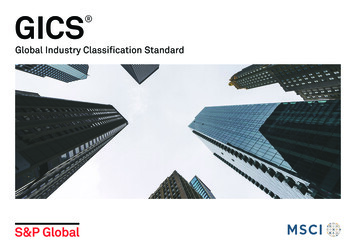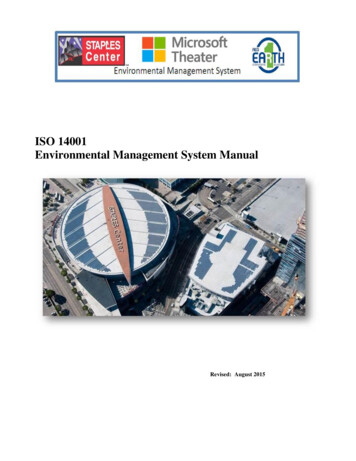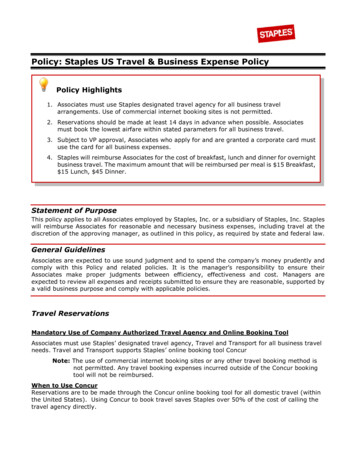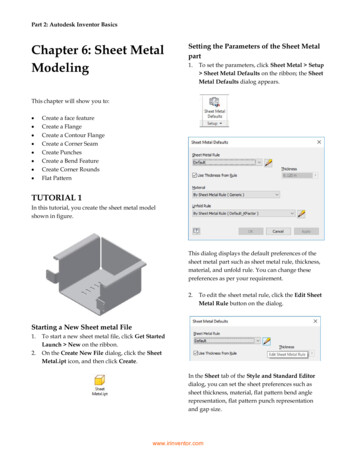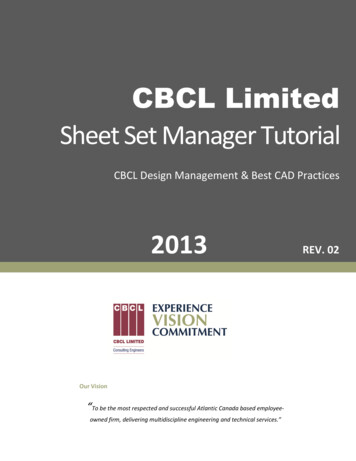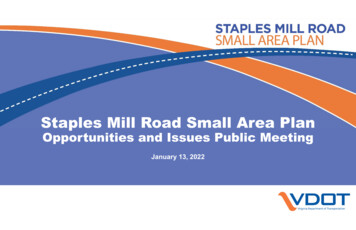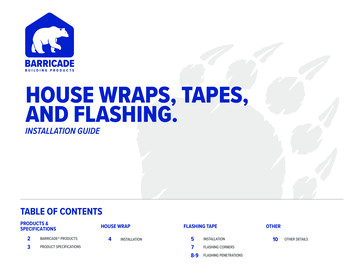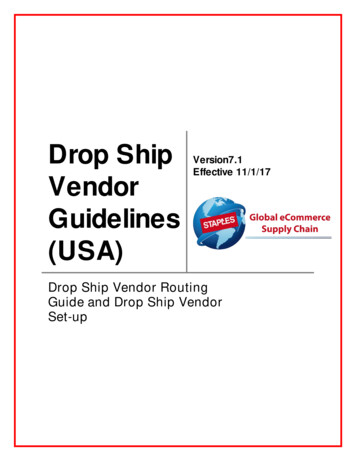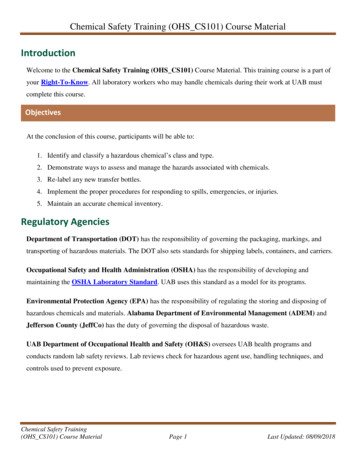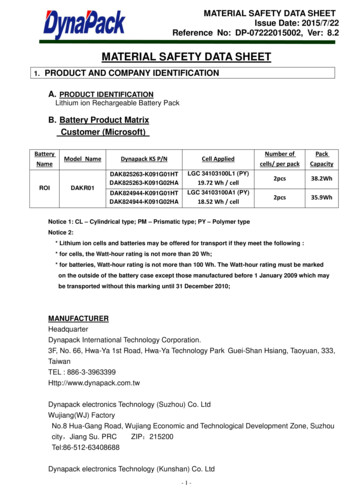
Transcription
MATERIAL SAFETY DATA SHEETIssue Date: 2015/7/22Reference No: DP-07222015002, Ver: 8.2MATERIAL SAFETY DATA SHEET1. PRODUCT AND COMPANY IDENTIFICATIONA. PRODUCT IDENTIFICATIONLithium ion Rechargeable Battery PackB. Battery Product MatrixCustomer (Microsoft)BatteryNameROIModel NameDAKR01Dynapack KS P/NCell AppliedDAK825263-K091G01HTDAK825263-K091G02HALGC 34103100L1 (PY)DAK824944-K091G01HTDAK824944-K091G02HALGC 34103100A1 (PY)19.72 Wh / cell18.52 Wh / cellNumber ofPackcells/ per packCapacity2pcs38.2Wh2pcs35.9WhNotice 1: CL – Cylindrical type; PM – Prismatic type; PY – Polymer typeNotice 2:* Lithium ion cells and batteries may be offered for transport if they meet the following :* for cells, the Watt-hour rating is not more than 20 Wh;* for batteries, Watt-hour rating is not more than 100 Wh. The Watt-hour rating must be markedon the outside of the battery case except those manufactured before 1 January 2009 which maybe transported without this marking until 31 December 2010;MANUFACTURERHeadquarterDynapack International Technology Corporation.3F, No. 66, Hwa-Ya 1st Road, Hwa-Ya Technology Park Guei-Shan Hsiang, Taoyuan, 333,TaiwanTEL : 886-3-3963399Http://www.dynapack.com.twDynapack electronics Technology (Suzhou) Co. LtdWujiang(WJ) FactoryNo.8 Hua-Gang Road, Wujiang Economic and Technological Development Zone, Suzhoucity,Jiang Su. PRCZIP:215200Tel:86-512-63408688Dynapack electronics Technology (Kunshan) Co. Ltd-1-
MATERIAL SAFETY DATA SHEETIssue Date: 2015/7/22Reference No: DP-07222015002, Ver: 8.2Kunshan(KS) FactoryNo.68 Taoyuan Road, Kunshan Export Processing Zone, Area B,Kunshan Jiang Su, PRCTel:86-512-57725688EMERGENCY CONTACT1 800-424-9300OUSIDE THE UNITED STATES1 703-527-38872. Hazards IdentificationPrimary routes of entry: Skin contact. Skin absorption, eye contact, inhalation and ingestion:NOSymptoms of exposure: Skin contact. No effect under routine handling and use.Skin absorption: No effect under routine handling and use.Eye contact: No effect under routine handling and use.Inhalation: No effect under routine handling and use.Reported as carcinogen: Not applicable3.Composition/information on ingredientsCompositionCAS number: Not specified (A-1 and A-2):A-1. Cases: Plastic or Metal Not dangerousA-2. Printed Circuit Board Assembly Not dangerousA-3. Lithium Ion Cell:Aluminum2%Metal Oxide (proprietary)20%Polyvinylidene fluoride (PVDF) 0%Copper2%Carbon (proprietary)10%Electrolyte (proprietary)10%-10%50%5%10%30%20%CAS Main Component:96-49-1,623-53-0,108-32-74. First Aid MeasuresIF EXPOSURE TO INTERNAL MATERIALS WITHIN CELL DUE TO DAMAGED OUTERCASING , THE FOLLOWING ACTIONS ARE RECOMMENDED.Inhalation: Leave area immediately and seek medical attention.Eye contact: Rinse eyes with water for 15 minutes and seek medical attention.Skin contact: Wash area thoroughly with soap and water and seek medical attention.-2-
MATERIAL SAFETY DATA SHEETIssue Date: 2015/7/22Reference No: DP-07222015002, Ver: 8.2Ingestion: Drink milk/water and induce vomiting; seek medical attention5. Fire Fighting MeasuresExtinguishing Media: Use extinguishing media suitable for the materials that are buring.Firefighting Equipment: Use NIOSH/MSHA approved full-face self-contained breathingapparatus ( SCBA) with full protective gear.6. Accidental Release MeasuresOn Land: Place material into suitable containers and call local fire/police department.In water: If possible. Remove from water and call local fire/police department7. Handling and StorageHandling:Do not expose the battery to excessive physical shock or vibration. Short-circuiting should beavoided. However, accidental short-circuiting for a few seconds will not seriously affect thebattery. Prolonged short circuits will cause the battery to rapidly lose energy, could generateenough heat to burn skin. Sources of short circuits include jumbled batteries in bulk containers,coins, metal jewelry, metal covered tables, or metal belts used for assembly of batteries indevices. To minimize risk of short-circuiting, the protective case supplied with the batteryshould be used to cover the terminals when transporting or storing the battery. Do notdisassemble or deform the battery. Should an individual cell within a battery become ruptured,do not allow contact with water.Storage:The lithium ion battery should be between 25% and 75% of full charge when stored for a longperiod of time. Store in a cool, dry, well ventilated area. And temperature above 100 degreesCelsius can result in loss of battery performance, leakage, or rust. Do not expose the battery toopen flames.8. Exposure Controls / Personal ProtectionEngineering Controls : Keep away from heat and open flame. Store in a cool dry place.Personal Protection :Respirator : Not required during normal operations. SCBA required in the event of a fire.Eye/Face Protection : Not required beyond safety practices of employer.Gloves : Not required for handling of batteryFoot Protection: Steel toed shoes recommended for large container handling.-3-
MATERIAL SAFETY DATA SHEETIssue Date: 2015/7/22Reference No: DP-07222015002, Ver: 8.29. Physical and Chemical PropertiesStateOdorPHVapor pressureVapor densityBoiling pointSolubility in waterSpecific 0. Stability and ReactivityReactivity: NoneIncompatibilities: None during normal operation. Avoid exposure to heat, open flame, andcorrosives.Conditions To Avoid: Avoid exposure to heat and open flame. Don not puncture, crush orincinerate.11. Toxicological InformationThis product does not elicit toxicological properties during routine handling and use.12. Ecological InformationLithium ion battery pack can be disposable in accordance with appropriate federal,state and local regulations.13. Disposal ConsiderationsRecommended methods for safe and environmentally preferred disposal:Product(waste from residues)Do not throw out a used battery. Recycle it through the recycling company.Contaminated packagingNeither a container nor packing is contaminated during normal use. When internal-4-
MATERIAL SAFETY DATA SHEETIssue Date: 2015/7/22Reference No: DP-07222015002, Ver: 8.2materials leaked from a battery contaminates, dispose as industrial wastessubject to special control.14. Transport InformationLithium ion batteries containing no more than 1.5g/cell and 8g/battery pack and also poweris no more than 20Wh/cell and 100Wh/battery pack of lithium can be treated as“Non-dangerous goods” under the United Nations Recommendations on the Transport ofDangerous Goods, Special Provision 188, provided that packaging is strong and prevent theproducts from short-circuit.With regard to air transport, the following regulations are cited and considered:- The International Civil Aviation Organization (ICAO) Technical Instructions (20152016 Edition)- The International Air Transport Association (IATA) Dangerous Goods Regulations.(56th Edition, 2015) Special Provisions A154, A164& package instruction Section II of965, 966 and 967 for lithium ion batteries)- The International Maritime Dangerous Goods (IMDG) Code (2014 Edition), SpecialProvision 188.- The US Hazardous Materials Regulation (HMR) pursuant to a final rule issued byRSPA (Part 49 CFR Sections 100-185),- The Office of Hazardous Materials Safety within the US Department ofTransportation’s (DOT) Research and Special Programs Administration (RSPA), and- The UN Recommendations on the Transport of Dangerous Goods Model Regulationsand the Manual of Tests and Criteria.Our products are properly classified, described, packaged, marked, and labeled, and arein proper condition for transportation according to all the applicable international andnational governmental regulations, not limited to the above mentioned. We furthercertify that the enclosed products have been tested and fulfilled the requirements andconditions in accordance with UN Recommendations 38.3 (T1-T8) on the Transport ofDangerous Goods Model Regulations and the Manual of Testes and Criteria that can betreated as “Non-Dangerous Goods”.15. Regulatory InformationOSHA Hazard communication standard (29 CFR 1910.1200) Hazardous-5-Non-hazardous
MATERIAL SAFETY DATA SHEETIssue Date: 2015/7/22Reference No: DP-07222015002, Ver: 8.216. Other information -- UN Test ResultThere is no hazards in accordance with the UN recommendations tests (Manual of Testsand Criteria , Part ΙΙΙ , sub-section 38.3 )NoITEMSRESULT1Altitude SimulationPass2Thermal ShockPass3VibrationPass4ShockPass5External ShortPass6ImpactPass7OverchargePass81.2m packing dropPass-6-REMARKSFor cell only
SAFETY DATA SHEETIssuing Date No data availableRevision Date 17-Aug-2015Revision Number 3The supplier identified below generated this SDS using the UL SDS template. UL did not test, certify, or approve the substance described in this SDS, andall information in this SDS was provided by the supplier or was reproduced from publically available regulatory data sources. UL makes no representationsor warranties regarding the completeness or accuracy of the information in this SDS and disclaims all liability in connection with the use of this informationor the substance described in this SDS. The layout, appearance and format of this SDS is 2014 UL LLC. All rights reserved.1. IDENTIFICATION OF THE SUBSTANCE/PREPARATION AND OF THECOMPANY/UNDERTAKINGProduct identifierProduct NameG3HTA027HOther means of identificationSynonymsNoneRecommended use of the chemical and restrictions on useRecommended UseLITHIUM ION BATTERIESUses advised againstNo information availableDetails of the supplier of the safety data sheetSupplier NameSImplo TechnologySupplier AddressNo.471,Sec.2, Pa The Rd., Hu Kou 303, Hsin Chu Hsien, TaiwanHsin Chu CountyTaiwan331TWSupplier Phone NumberPhone: 88635695920Fax: 88635695931Supplier EmailAnderson Hsu@simplo.com.cnEmergency telephone numberCompany Emergency PhoneNumber 886356959202. HAZARDS IDENTIFICATIONClassificationThis chemical is not considered hazardous by the 2012 OSHA Hazard Communication Standard (29 CFR 1910.1200). This productis an article which is a sealed battery and as such does not require an MSDS per the OSHA hazard communication standardunless ruptured. The hazards indicated are for a ruptured battery.Acute toxicity - OralAcute toxicity - Inhalation (Gases)Category 4Category 4Page 1 / 13
Revision Date 17-Aug-20151264485 - G3HTA027HSkin sensitizationCarcinogenicitySpecific target organ toxicity (repeated exposure)Category 1Category 1ACategory 1GHS Label elements, including precautionary statementsEmergency OverviewSignal wordDangerHazard StatementsMay cause an allergic skin reactionMay cause cancerThis product is an article which contains a chemical substance. Safety information is given for exposure to the article as sold.Intended use of the product should not result in exposure to the chemical substance. This is a battery. In case of rupture: theabove hazards exist.Appearance No information availablePhysical state SolidOdor No information availablePrecautionary Statements - PreventionObtain special instructions before useDo not handle until all safety precautions have been read and understoodUse personal protective equipment as requiredWash face, hands and any exposed skin thoroughly after handlingDo not eat, drink or smoke when using this productUse only outdoors or in a well-ventilated areaContaminated work clothing should not be allowed out of the workplaceWear protective glovesDo not breathe dust/fume/gas/mist/vapors/sprayPrecautionary Statements - ResponseIF exposed or concerned: Get medical advice/attentionSpecific treatment (see supplemental first aid instructions on this label)SkinIF ON SKIN: Wash with plenty of soap and waterIf skin irritation or rash occurs: Get medical advice/attentionWash contaminated clothing before reuseInhalationIF INHALED: Remove victim to fresh air and keep at rest in a position comfortable for breathingIngestionIF SWALLOWED: Call a POISON CENTER or doctor/physician if you feel unwellRinse mouthPrecautionary Statements - StorageStore locked upPage 2 / 13
Revision Date 17-Aug-20151264485 - G3HTA027HPrecautionary Statements - DisposalDispose of contents/container to an approved waste disposal plantHazards not otherwise classified (HNOC)Not applicableUnknown Toxicity19.8 % of the mixture consists of ingredient(s) of unknown toxicityOther informationCauses mild skin irritationVery toxic to aquatic life with long lasting effectsRepeated or prolonged skin contact may cause allergic reactions with susceptible personsInteractions with Other ChemicalsNo information available.3. COMPOSITION/INFORMATION ON INGREDIENTS.Chemical NameNickel oxideManganese dioxideCobalt(II) oxideAluminumCopperCAS NoWeight-%Trade Secret1313-99-110 - 30*1313-13-910 - 30*1307-96-610 - 30*7429-90-53-7*7440-50-81-5**The exact percentage (concentration) of composition has been withheld as a trade secret4. FIRST AID MEASURESFirst aid measuresGeneral AdviceFirst aid is upon rupture of sealed battery.Eye contactRinse thoroughly with plenty of water, also under the eyelids. If symptoms persist, call aphysician.Skin contactWash with soap and water. May cause an allergic skin reaction. In the case of skin irritationor allergic reactions see a physician.InhalationRemove to fresh air.IngestionDo NOT induce vomiting. Rinse mouth immediately and drink plenty of water. Never giveanything by mouth to an unconscious person. Call a physician.Most important symptoms and effects, both acute and delayedMost Important Symptoms andEffectsItching. Coughing and/ or wheezing.Indication of any immediate medical attention and special treatment neededPage 3 / 13
Revision Date 17-Aug-20151264485 - G3HTA027HNotes to PhysicianMay cause sensitization in susceptible persons. Treat symptomatically.5. FIRE-FIGHTING MEASURESSuitable Extinguishing MediaUse extinguishing measures that are appropriate to local circumstances and the surrounding environment.Unsuitable extinguishing mediaCAUTION: Use of water spray when fighting fire may be inefficient.Specific hazards arising from the chemicalProduct is or contains a sensitizer. May cause sensitization by skin contact.Hazardous Combustion ProductsCarbon oxides.Explosion DataSensitivity to Mechanical ImpactNo.Sensitivity to Static DischargeNo.Protective equipment and precautions for firefightersAs in any fire, wear self-contained breathing apparatus pressure-demand, MSHA/NIOSH (approved or equivalent) and fullprotective gear.6. ACCIDENTAL RELEASE MEASURESPersonal precautions, protective equipment and emergency proceduresPersonal precautionsAvoid contact with skin, eyes or clothing. Use personal protective equipment as required.Ensure adequate ventilation. Evacuate personnel to safe areas.Other InformationRefer to protective measures listed in Sections 7 and 8.Environmental precautionsEnvironmental precautionsRefer to protective measures listed in Sections 7 and 8.Methods and material for containment and cleaning upMethods for containmentPrevent further leakage or spillage if safe to do so.Methods for cleaning upPick up and transfer to properly labeled containers.Page 4 / 13
Revision Date 17-Aug-20151264485 - G3HTA027H7. HANDLING AND STORAGEPrecautions for safe handlingIn case of rupture: Handle in accordance with good industrial hygiene and safety practice.Avoid contact with skin, eyes or clothing. Do not eat, drink or smoke when using thisproduct. Take off contaminated clothing and wash before reuse.HandlingConditions for safe storage, including any incompatibilitiesStorageKeep containers tightly closed in a dry, cool and well-ventilated place. Keep out of the reachof children. Store locked up.Incompatible ProductsNone known based on information supplied.8. EXPOSURE CONTROLS/PERSONAL PROTECTIONControl parametersExposure GuidelinesChemical NameNickel oxide1313-99-1ACGIH TLVTWA: 0.2 mg/m3OSHA PELTWA: 1 mg/m3 Ni(vacated) TWA: 1 mg/m3 NiManganese dioxide1313-13-9TWA: 0.02 mg/m3 MnTWA: 0.1 mg/m3 Mn(vacated) Ceiling: 5 mg/m3Ceiling: 5 mg/m3 MnCobalt(II) oxide1307-96-6Aluminum7429-90-5TWA: 0.02 mg/m3 Co-NIOSH IDLHIDLH: 10 mg/m3 NiTWA: 0.015 mg/m3 except Nickelcarbonyl NiIDLH: 500 mg/m3 MnTWA: 1 mg/m3 MnSTEL: 3 mg/m3 MnTWA: 1 mg/m3 respirable fractionTWA: 15 mg/m3 total dustTWA: 10 mg/m3 total dustTWA: 5 mg/m3 respirable fraction TWA: 5 mg/m3 respirable dust(vacated) TWA: 15 mg/m3 totaldust(vacated) TWA: 5 mg/m3respirable fraction (vacated)TWA: 5 mg/m3 Al AluminumCopperTWA: 0.2 mg/m3 fume TWA: 1TWA: 0.1 mg/m3 fumeIDLH: 100 mg/m3 dust, fume and7440-50-8mg/m3 Cu dust and mistTWA: 1 mg/m3 dust and mistmist(vacated) TWA: 0.1 mg/m3 CuTWA: 1 mg/m3 dust and mistdust, fume, mistTWA: 0.1 mg/m3 fumeACGIH TLV: American Conference of Governmental Industrial Hygienists - Threshold Limit Value OSHA PEL: Occupational Safety and HealthAdministration - Permissible Exposure Limits NIOSH IDLH Immediately Dangerous to Life or HealthAppropriate engineering controlsEngineering MeasuresShowersEyewash stationsVentilation systemsIndividual protection measures, such as personal protective equipmentEye/face protectionWear safety glasses with side shields (or goggles).Skin and body protectionWear protective gloves and protective clothing.Page 5 / 13
Revision Date 17-Aug-20151264485 - G3HTA027HRespiratory protectionNo protective equipment is needed under normal use conditions. If exposure limits areexceeded or irritation is experienced, ventilation and evacuation may be required.Hygiene MeasuresHandle in accordance with good industrial hygiene and safety practice. Do not eat, drink orsmoke when using this product. Wash hands before breaks and immediately after handlingthe product.9. PHYSICAL AND CHEMICAL PROPERTIESPhysical and Chemical PropertiesPhysical stateAppearanceColorSolidNo information availableNo information availablePropertyValuesNo data availablepHNo data availableMelting / freezing pointNo data availableBoiling point / boiling rangeNo data availableFlash PointNo data availableEvaporation RateNo data availableFlammability (solid, gas)Flammability Limit in AirNo data availableUpper flammability limitNo data availableLower flammability limitNo data availableVapor pressureNo data availableVapor densityNo data availableSpecific GravityNo data availableWater SolubilityNo data availableSolubility in other solventsPartition coefficient: n-octanol/waterNo data availableNo data availableAutoignition temperatureNo data availableDecomposition temperatureNo data availableKinematic viscosityNo data availableDynamic viscosityNo data availableExplosive propertiesNo data availableOxidizing propertiesOdorOdor ThresholdNo information availableNo information availableRemarks MethodNone knownNone knownNone knownNone knownNone knownNone knownNone knownNone knownNone knownNone knownNone knownNone knownNone knownNone knownNone knownNone knownOther InformationSoftening PointVOC Content (%)Particle SizeParticle Size DistributionNo data availableNo data availableNo data availablePage 6 / 13
Revision Date 17-Aug-20151264485 - G3HTA027H10. STABILITY AND REACTIVITYReactivityNo data available.Chemical stabilityStable under recommended storage conditions.Possibility of Hazardous ReactionsNone under normal processing.Hazardous PolymerizationHazardous polymerization does not occur.Conditions to avoidNone known based on information supplied.Incompatible materialsNone known based on information supplied.Hazardous Decomposition ProductsCarbon oxides.11. TOXICOLOGICAL INFORMATIONInformation on likely routes of exposureProduct does not present an acute toxicity hazard based on known or supplied information.In case of rupture:.Product InformationInhalationSpecific test data for the substance or mixture is not available.Eye contactSpecific test data for the substance or mixture is not available.Skin contactSpecific test data for the substance or mixture is not available.IngestionSpecific test data for the substance or mixture is not available. Harmful if swallowed. (basedon components).Component InformationChemical NameNickel oxide1313-99-1Manganese dioxide1313-13-9Oral LD50 5000 mg/kg ( Rat )Dermal LD50-Inhalation LC50- 9000 mg/kg ( Rat )--Information on toxicological effectsSymptomsItching. Rashes. Hives.Delayed and immediate effects as well as chronic effects from short and long-term exposureSensitizationMay cause sensitization in susceptible persons. May cause sensitization by skin contact.Mutagenic EffectsNo information available.CarcinogenicityThe table below indicates whether each agency has listed any ingredient as a carcinogen.Chemical NameACGIHIARCNTPOSHAPage 7 / 13
Revision Date 17-Aug-20151264485 - G3HTA027HNickel oxideA1Group 11313-99-1Cobalt(II) oxideA3Group 2B1307-96-6ACGIH (American Conference of Governmental Industrial Hygienists)A1 - Known Human CarcinogenA3 - Animal CarcinogenIARC (International Agency for Research on Cancer)Group 1 - Carcinogenic to HumansGroup 2B - Possibly Carcinogenic to HumansNTP (National Toxicology Program)Known - Known CarcinogenOSHA (Occupational Safety and Health Administration of the US Department of Labor)X - PresentKnownXXReproductive toxicityNo information available.STOT - single exposureNo information available.STOT - repeated exposureCauses damage to organs through prolonged or repeated exposure. Based onclassification criteria from the 2012 OSHA Hazard Communication Standard (29 CFR1910.1200), this product has been determined to cause systemic target organ toxicity fromchronic or repeated exposure. (STOT RE).Chronic ToxicityNo known effect based on information supplied. Contains a known or suspectedcarcinogen. Avoid repeated exposure. Prolonged exposure may cause chronic effects.Target Organ EffectsSkin. Respiratory system. Eyes. Gastrointestinal tract (GI).Aspiration HazardNo information available.Numerical measures of toxicity Product InformationThe following values are calculated based on chapter 3.1 of the GHS documentATEmix (oral)1,010.00 mg/kgATEmix (inhalation-gas)18,320.00 ppm (4 hr)ATEmix (inhalation-dust/mist)6.08 mg/lATEmix (inhalation-vapor)44.78 ATEmixPage 8 / 13
Revision Date 17-Aug-20151264485 - G3HTA027H12. ECOLOGICAL INFORMATIONEcotoxicityVery toxic to aquatic life with long lasting effects.Chemical NameToxicity to AlgaeNickel oxide1313-99-1Toxicity to FishToxicity toMicroorganisms72h EC50: 127.3 mg/L96h LC50: 100 mg/L(Pseudokirchneriella(Brachydanio rerio)subcapitata)96h EC50: 0.031 - 0.054 96h LC50: 0.0068 - 0.0156mg/L (Pseudokirchneriella mg/L (Pimephales promelas)subcapitata) 72h EC50:96h LC50: 0.112 mg/L0.0426 - 0.0535 mg/L(Poecilia reticulata) 96h(PseudokirchneriellaLC50: 0.3 mg/L (Cyprinussubcapitata)carpio) 96h LC50: 0.8mg/L (Cyprinus carpio) 96hLC50: 1.25 mg/L (Lepomismacrochirus) 96h LC50: 0.052 mg/L (Oncorhynchusmykiss) 96h LC50: 0.2mg/L (Pimephales promelas)96h LC50: 0.3 mg/L(Pimephales promelas)Copper7440-50-8Daphnia Magna (WaterFlea)48h EC50: 100 mg/L48h EC50: 0.03 mg/LPersistence and DegradabilityNo information available.BioaccumulationChemical NameManganese dioxide1313-13-9Log Pow 0Other adverse effectsNo information available.Page 9 / 13
Revision Date 17-Aug-20151264485 - G3HTA027H13. DISPOSAL CONSIDERATIONSWaste treatment methodsDisposal methodsThis material, as supplied, is not a hazardous waste according to Federal regulations (40CFR 261). This material could become a hazardous waste if it is mixed with or otherwisecomes in contact with a hazardous waste, if chemical additions are made to this material, orif the material is processed or otherwise altered. Consult 40 CFR 261 to determine whetherthe altered material is a hazardous waste. Consult the appropriate state, regional, or localregulations for additional requirements.Contaminated PackagingDispose of contents/containers in accordance with local regulations.California Hazardous Waste Codes 141This product contains one or more substances that are listed with the State of California as a hazardous waste.Chemical NameCobalt(II) fornia Hazardous WasteToxicIgnitable powderToxic14. TRANSPORT INFORMATIONNote:The transportation of primary lithium cells and batteries is regulated by the InternationalCivil Aviation Organization, International Air Transport Association, International MaritimeDangerous Goods Code and the US Department of Transportation. The batteries mustmeet the following criteria for shipment: 1. Air shipments must meet the requirementslisted in Special Provision A45 of the International Air Transport Association DangerousGoods Regulations. 2. Meet the requirements for the US Department of Transportationlisted in 49 CFR 173.185. 3. The transport of primary lithium batteries is prohibited aboardpassenger aircraft. Refer to the Federal Register December 15, 2004 (HazardousMaterials; Prohibited on the Transportation of Primary Lithium Batteries and Cells AboardPassenger Aircraft; Final Rule)Lithium batteries shipped as "Lithium batteries", "Lithium batteries packed with equipment",or "Lithium batteries contained in equipment" may not be classified as "Dangerous Goods"when shipped in accordance with "special provision A45 of IATA-DGR" or "special provision188 of IMO-IMDG Code"DOTProper Shipping NameHazard ClassEmergency Response GuideNumberNOT REGULATEDNON-REGULATEDN/A147TDGNot regulatedMEXNot regulatedICAONot regulatedIATAProper Shipping NameHazard ClassNot regulatedNON REGULATEDN/APage 10 / 13
Revision Date 17-Aug-20151264485 - G3HTA027HIMDG/IMOHazard ClassEmS-No.Not regulatedN/AF-A, S-IRIDNot regulatedADRNot regulatedADNNot regulated15. REGULATORY INFORMATIONInternational InventoriesTSCADSLCompliesAll components are listed either on the DSL or NDSL.TSCA - United States Toxic Substances Control Act Section 8(b) InventoryDSL/NDSL - Canadian Domestic Substances List/Non-Domestic Substances ListUS Federal RegulationsSARA 313Section 313 of Title III of the Superfund Amendments and Reauthorization Act of 1986 (SARA). This product contains a chemicalor chemicals which are subject to the reporting requirements of the Act and Title 40 of the Code of Federal Regulations, Part 372Chemical NameNickel oxide - 1313-99-1Manganese dioxide - 1313-13-9Cobalt(II) oxide - 1307-96-6Aluminum - 7429-90-5Copper - 7440-50-8CAS -50-810 - 3010 - 3010 - 303-71-5SARA 311/312 Hazard CategoriesAcute Health HazardChronic Health HazardFire HazardSudden release of pressure hazardReactive HazardSARA 313 - ThresholdValues %0.11.00.11.01.0NoNoNoNoNoCWA (Clean Water Act)This product contains the following substances which are regulated pollutants pursuant to the Clean Water Act (40 CFR 122.21and 40 CFR 122.42)Chemical NameCWA - ReportableQuantitiesCWA - Toxic PollutantsNickel oxide1313-99-1Copper7440-50-8CWA - Priority PollutantsCWA - HazardousSubstancesXXXCERCLAThis material, as supplied, contains one or more substances regulated as a hazardous substance under the ComprehensiveEnvironmental Response Compensation and Liability Act (CERCLA) (40 CFR 302)Chemical NameHazardous Substances RQsCopper7440-50-85000 lbExtremely Hazardous SubstancesRQsRQRQ 5000 lb final RQRQ 2270 kg final RQUS State RegulationsPage 11 / 13
Revision Date 17-Aug-20151264485 - G3HTA027HCalifornia Proposition 65This product contains the following Proposition 65 chemicals.Chemical NameCobalt(II) oxide - 1307-96-6Nickel oxide - 1313-99-1California Proposition 65CarcinogenCarcinogenU.S. State Right-to-Know Regulations.Chemical NameCarbon7440-44-0Cobalt(II) oxide1307-96-6Manganese dioxide1313-13-9Nickel oxide1313-99-1Dimethyl in7440-31-5New JerseyMassachusettsPennsylvaniaXRhode nal RegulationsMexicoNational occupational exposure limitsComponentManganese dioxide1313-13-9 ( 10 - 30 )Aluminum7429-90-5 ( 3 - 7 )Copper7440-50-8 ( 1 - 5 )Carcinogen StatusExposure LimitsMexico: TWA 0.2 mg/m3Mexico: TWA 10 mg/m3Mexico: TWA 1 mg/m3Mexico: TWA 0.2 mg/m3Mexico: STEL 2 mg/m3Mexico - Occupational Exposure Limits - CarcinogensCanadaWHMIS Hazard ClassNot determined16. OTHER INFORMATIONNFPAHealth Hazards 0Flammability 0Instability 0HMISHealth Hazards 0Flammability 0Physical Hazard 0Physical andChemical Hazards Personal ProtectionXProduct Stewardship23 British American Blvd.Latham, NY 121101-800-572-650117-Aug-2015Revision DateNo information availableRevision NotePrepared ByPage 12 / 13
Revision Date 17-Aug-20151264485 - G3HTA027HDisclaimerThe information provided in this Safety Data Sheet is correct to the best of our knowledge, information and belief atthe date of its publication. The information given is designed only as a guidance for safe handling, use, processing,storage, transportation, disposal and release and is not to be considered a warranty or quality specification. Theinformation relates only to the specific material designated and may not be valid for such material used in combinationwith any other materials or in any process, unless specified in the textEnd of Safety Data SheetPage 13 / 13
Issue Date: 2015/7/22 Reference No: DP-07222015002, Ver: 8.2 - 1 - . (IATA) Dangerous Goods Regulations. (56th Edition, 2015) . Dangerous Goods Model Regulations and the Manual of Testes and Criteria that can be treated as "Non-Dangerous Goods". 15. Regulatory Information
